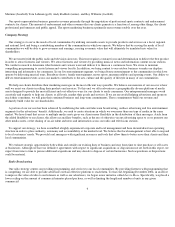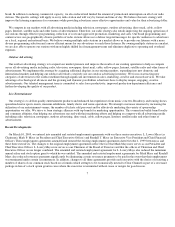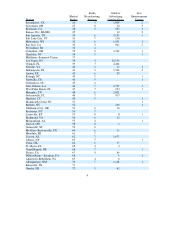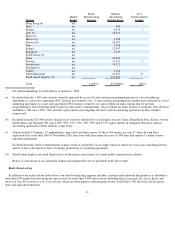iHeartMedia 2004 Annual Report Download - page 16
Download and view the complete annual report
Please find page 16 of the 2004 iHeartMedia annual report below. You can navigate through the pages in the report by either clicking on the pages listed below, or by using the keyword search tool below to find specific information within the annual report.
stations in these markets than is permitted by the current rule. The FCC has given us a temporary period of time to divest the necessary radio or
television stations to come into compliance with the rule. We have completed such divestiture with respect to one such market. In the other
markets where our number of radio stations exceeds the limit under the current rule, we are nonetheless authorized to retain our present
television/radio combinations at least until the FCC’s next periodic ownership rule review. As with grandfathered television LMAs, we may
seek permanent authorization for our non-compliant radio/television combinations by demonstrating to the FCC, among other things, the public
interest benefits the combinations have produced and the extent to which the combinations have enabled the television stations involved to
convert to digital operation.
Under the FCC’s ownership rules, an officer or director of our company or a direct or indirect purchaser of certain types of our securities
could cause us to violate FCC regulations or policies if that purchaser owned or acquired an “attributable” interest in other media properties in
the same areas as our stations or in a manner otherwise prohibited by the FCC. All officers and directors of a licensee and any direct or indirect
parent, general partners, limited partners and limited liability company members who are not properly “insulated” from management activities,
and stockholders who own five percent or more of the outstanding voting stock of a licensee or its parent, either directly or indirectly, generally
will be deemed to have an attributable interest in the licensee. Certain institutional investors who exert no control or influence over a licensee
may own up to twenty percent of a licensee’s or its parent’s outstanding voting stock before attribution occurs. Under current FCC regulations,
debt instruments, non-voting stock, minority voting stock interests in corporations having a single majority shareholder, and properly insulated
limited partnership and limited liability company interests as to which the licensee certifies that the interest holders are not “materially
involved” in the management and operation of the subject media property generally are not subject to attribution unless such interests implicate
the FCC’s “equity/debt plus,” or “EDP,” rule. Under the EDP rule, an aggregate debt and/or equity interest in excess of 33% of a licensee’s
total asset value (equity plus debt) is attributable if the interest holder is either a major program supplier (providing over 15% of the licensee’s
station’s total weekly broadcast programming hours) or a same-market media owner (including broadcasters, cable operators, and newspapers).
To the best of our knowledge at present, none of our officers, directors or five percent or greater stockholders holds an interest in another
television station, radio station, cable television system or daily newspaper that is inconsistent with the FCC’s ownership rules and policies.
Recent Developments and Future Actions Regarding Multiple Ownership Rules
Expansion of our broadcast operations in particular areas and nationwide will continue to be subject to the FCC’s ownership rules and any
further changes the FCC or Congress may adopt. Recent actions by and pending proceedings before the FCC, Congress and the courts may
significantly affect our business.
The 1996 Act requires the FCC to review its remaining ownership rules biennially as part of its regulatory reform obligations (although,
under recently enacted appropriations legislation, the FCC will be obligated to review the rules every four years rather than biennially). The
first two biennial reviews did not result in any significant changes to the FCC’s media ownership rules, although the first such review led to the
commencement of several separate proceedings concerning specific rules.
In its third biennial review, which commenced in September 2002, the FCC undertook a comprehensive review and reevaluation of all of its
media ownership rules, including incorporation of a previously commenced separate rulemaking on the radio ownership rules. This biennial
review culminated in a decision adopted by the FCC in June 2003, in which the agency made significant changes to virtually all aspects of the
existing media ownership rules. Among other things:
15
• The FCC relaxed the local television ownership rule, allowing common ownership of two television stations in any DMA with at
least five operating commercial and non-commercial television stations. Under the modified rule, a company may own three
television stations in a DMA with at least 18 television stations. In either case, no single entity may own more than one television
station that is among the top four stations in a DMA based on audience ratings. In markets with eleven or fewer television stations,
however, the modified rule would allow parties to seek waivers of the “top four” restriction and permit a case-by-case evaluation of
whether joint ownership would serve the public interest, based on a liberalized set of waiver criteria.
























